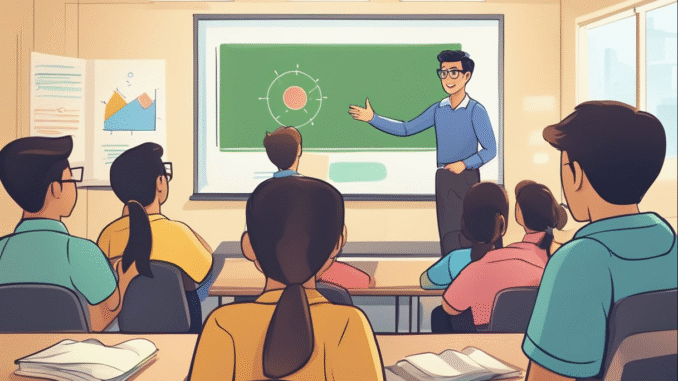
Top 10 Modern Teaching Methods That Improve Student Learning in 2025
Education is evolving faster than ever in 2025. With the rise of technology, changing student needs, and new insights into how people learn, traditional chalk-and-talk methods alone are no longer enough. Teachers, schools, and universities are embracing innovative methods that not only make learning more effective but also engaging and future-ready.
This article explores the top 10 modern teaching methods in 2025 that are transforming classrooms and helping students succeed academically and personally.
1. Blended Learning
Blended learning combines traditional classroom teaching with online tools and resources. Instead of relying only on lectures, teachers use videos, interactive quizzes, and digital assignments to enhance understanding.
- Why it works: Students get flexibility to learn at their own pace while still benefiting from face-to-face guidance.
- Example: A math teacher may explain a concept in class, then assign an online simulation game that lets students practice in real time.
Blended learning bridges the gap between technology and human interaction, making it one of the most effective modern teaching approaches.
2. Project-Based Learning (PBL)
Project-based learning emphasizes real-world problem-solving. Instead of memorizing facts, students work on projects that require creativity, research, teamwork, and critical thinking.
- Why it works: It prepares students for practical situations they will face in higher education or careers.
- Example: High school science students might design a sustainable energy model or investigate local water pollution issues.
By focusing on projects, students take ownership of their learning while developing collaboration and problem-solving skills.
3. Gamification of Learning
Gamification turns lessons into games by using challenges, points, levels, and rewards. In 2025, gamification is especially popular due to students’ growing interest in interactive platforms.
- Why it works: Games make learning fun and increase motivation while improving memory retention.
- Example: Language teachers use apps where students earn badges for completing vocabulary challenges or participating in class quizzes.
This method promotes friendly competition, teamwork, and consistent engagement.
4. Flipped Classroom Approach
In a flipped classroom, students learn basic concepts at home through videos, articles, or podcasts. Classroom time is then used for discussions, problem-solving, and hands-on activities.
- Why it works: Students come prepared and actively engage during class rather than passively listening.
- Example: Before a history lesson, students watch a short documentary. In class, they debate causes and effects of historical events.
This approach encourages critical thinking, deeper understanding, and teacher-student interaction.
5. Personalized Learning
Every student has unique learning needs, abilities, and interests. Personalized learning adapts teaching methods and resources to suit each learner.
- Why it works: Students learn at their own pace, focusing more on areas they find challenging.
- Example: A student struggling in math may receive additional exercises online, while another excelling in science is given advanced projects.
In 2025, AI-driven tools and analytics are making personalization easier and more effective for teachers.
6. Experiential Learning
Experiential learning focuses on learning by doing. Instead of only listening, students engage in activities, simulations, or real-life experiences that connect theory with practice.
- Why it works: Practical experiences leave a lasting impact compared to textbook knowledge alone.
- Example: Business students run a mock company to understand entrepreneurship, finance, and teamwork.
This hands-on approach fosters curiosity, critical analysis, and confidence in applying knowledge to real-life situations.
7. Collaborative Learning
Collaboration plays a key role in modern education. Collaborative learning emphasizes teamwork where students learn from each other through group discussions, peer reviews, and shared projects.
- Why it works: It builds communication skills, empathy, and leadership qualities.
- Example: University students work in groups to research climate change solutions and present them together.
This method mirrors workplace environments, preparing students for professional teamwork.
8. Inquiry-Based Learning
Instead of directly providing answers, teachers encourage students to ask questions, investigate, and explore topics themselves. Inquiry-based learning stimulates curiosity and independent thinking.
- Why it works: It helps students become active learners rather than passive receivers of information.
- Example: In a biology class, students investigate why bees are declining and propose solutions after their research.
This method enhances research skills, creativity, and problem-solving abilities.
9. Integration of Technology and AI Tools
Technology is no longer just a supporting tool—it is central to learning in 2025. From AI tutors and virtual reality (VR) labs to online learning platforms, digital tools are revolutionizing classrooms.
- Why it works: Technology offers personalized content, real-time feedback, and global access to resources.
- Example: A student struggling in English grammar may use an AI-powered app that corrects errors instantly and explains rules.
By combining AI with teacher guidance, students experience more efficient and interactive learning.
10. Mindfulness and Holistic Teaching
Education in 2025 is not only about academic success but also emotional well-being. Teachers now integrate mindfulness, meditation, and social-emotional learning into classrooms.
- Why it works: It reduces stress, improves focus, and builds emotional intelligence.
- Example: At the beginning of class, students spend five minutes practicing breathing exercises before diving into lessons.
This method supports both mental health and academic performance, creating a balanced learning environment.
Conclusion
Modern education in 2025 is dynamic, student-centered, and technology-driven. These top 10 teaching methods—from blended learning and gamification to personalized and inquiry-based approaches—are shaping smarter, more engaged, and future-ready learners.
By combining innovation with traditional wisdom, teachers are not just preparing students for exams but equipping them with lifelong skills to succeed in an ever-changing world.
